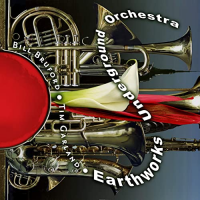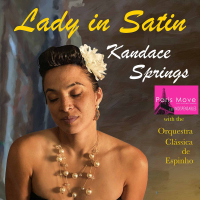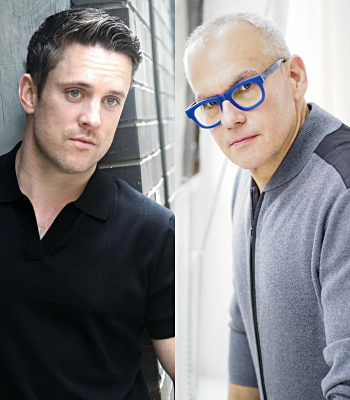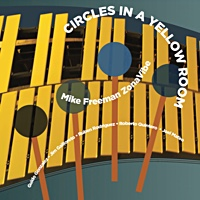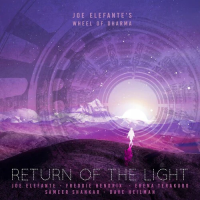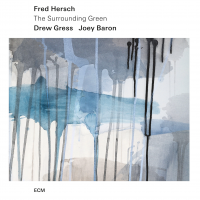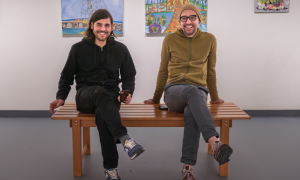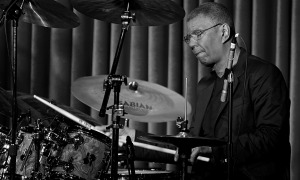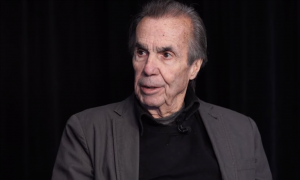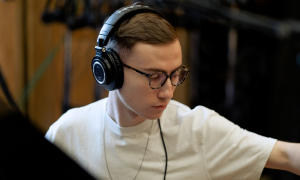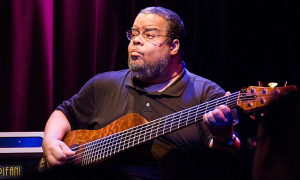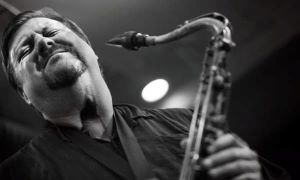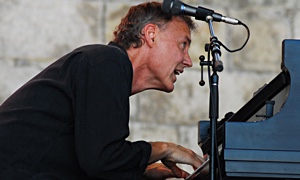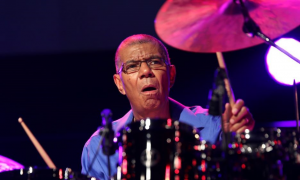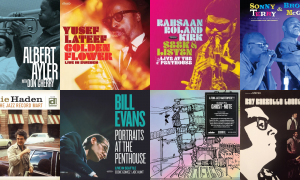Home » Jazz Articles » Interview » Marc Edwards: Free Jazz Drummer & Percussionist
Marc Edwards: Free Jazz Drummer & Percussionist
AAJ: Give us your impressions of Cecil Taylor. What did you think of him as a musician?
ME: What I liked about Cecil Taylor is that he held long rehearsals. Cecil asked me to come early before the horn players. I would arrive one or two hours early. I could hear Cecil playing as I walked up the stairs. He was already practicing. Cecil had a dog at the time. His dog was very quiet. He would sit there and listen to Cecil play for hours. I thought to myself, "A damn dog has more sense than some of these critics. All you have to do is listen to the music. You'll get it eventually. Every once in a while Cecil would look at the dog and he'd pat him on his head—a Hallmark card Kodak moment! I learned that Cecil has a much wider musical range than he's given credit by the writers. I played with Cecil, just the two of us, and learned how to play his music. I think my drumming had a tendency to clash with what he was doing, but, Cecil didn't mind the energy I brought to the group. Some of this has been captured on record.. During those duets, I didn't use my high energy approach, it wasn't necessary. I had only a partial drum kit. I couldn't play loudly at this location. Although it was Cecil's loft, he had neighbors.
I'd like to see the Blue Note performance Cecil did at the Blue Note celebration put on DVD, plus many of his other performances. Where most musicians go astray is that they jump right into the high energy aspect of Cecil's playing. Yes, that is a part of it, however, Cecil gives out melodic lines and he does that for a reason. I see too many musicians who ignore the lines and try to do their own thing. This is very stupid on the part of the musicians. I've heard critics talk about David S. Ware, and that talk is light years from the truth. David, more than most, knows how to make the lines sing, although I will say that Jimmy Lyons did it better than anyone else because he was with Cecil for his entire musical career. I wish Jimmy had done more things under his name and that he had lived longer. Cecil is one of the most significant musicians in jazz. He should be getting even more attention than he's getting. There should be an effort to bring his music to a wider audience; hence, this is why jazz needs to be on television.
Before I joined Cecil's Unit, I did go to Boston to the Jazz Workshop and they had finished playing for the night. I don't remember what year this was. My best guess is it took place after we did the performance at Carnegie Hall. It could have been in the fall of 1974 or 1975. Cecil, Jimmy and Andrew were both surprised and pleased to see me as I walked into the club. They were standing in my line of sight as I made my entry. I'll have to get in touch with Rick Lopez about this. He's trying to keep track of Cecil's performances.
Getting back to Apogee and David S. Ware, David can play almost anything you write for him. He's an accomplished horn player. You can't say that about some of the horn players in free jazz.
AAJ: Like anyone in particular?
ME: Because of my duo with Paul Flaherty, already one writer is suggesting that I work with Peter Brötzmann. I was at the filming of Rising Tones Cross with Charles Gayle. The problem is I was not moved by what Peter's doing. It's not very likely that we'll come together. I've already been with the best horn players: David S. Ware, Charles Gayle, Sabir Mateen and even Rob Brown. Ras Moshe, one of the upcoming horn players is more interesting to my ears than Mr. Brötzmann. If you're a musician and you think you have what it takes to do a duo, trio, quartet album, feel free to get in touch. I may say yes, you never know. My contact information is near the end of this interview.
My primary focus is working with the members in my current band, Tor, Ras, and James. I should also mention that because of my lifestyle and interest in yoga and meditation, it is not possible for me to work with everybody. I prefer to work with clean musicians who don't do drugs or are not too heavy into alcohol. These elements tend to lower one's creativity in my opinion. Some will say drugs can help. While that may be true, over time, it takes more drugs to get to those peak experiences, those moments of creative insights. In the meanwhile, drugs will begin to have a negative impact on the body. The same is true for alcohol. The law of diminishing returns will start kicking in. The focus of the individual will shift from creativity to that of drugs and/or alcohol only. Aren't drugs and alcohol an arduous means for a brief moment of epiphany?
For those who are interested, here is the schedule of the Cecil Taylor Unit European tour, summer of 1976:
We left New York City on June 14, 1976 at 8:45 pm.
We arrived in London and killed time by visiting Ronnie's and general sight seeing in London for about an hour before heading back to the airport. I quickly learned that I was no longer in America when I went into a store and asked for a quart of orange juice. "You mean a liter of orange juice, was the rebuttal from the female store clerk with a soft British accent. I had forgotten that the metric system is used over here. From Heathrow Airport, we made a connection for a flight to Yugoslavia.
18 June 1976 Ljublana, Yugoslavia—Airport security guards had machine guns and they looked like they were ready to use them. "Go ahead, do something wrong, was the look they had on their faces, "so we can blow your stupid ass away! Dark Unto Themselves was recorded here. I was relieved when we were in the air leaving the country. This was the band's first performance on this tour. My drums arrived late. They didn't get to Yugoslavia until the day that we were leaving. I remember talking to a Yugoslavian official at the airport who bore a strong resemblance to the actor, John Wayne. He didn't talk like him, but, he did look the part. Believe it or not, this is a true story.
20 June 1976 Rotterdam, Holland—The people in Holland were very friendly. They made me feel at home.
23 June 1976 Paris (with Archie Shepp)—Shepp's band played opposite us He also played opposite us at the Keystone Korner in San Francisco during the week in March 1976.
25 June 1976 Oslo, Norway—The only thing I remember is that I couldn't sleep in the hotel. The sun never completely sets in the Scandinavian countries. It always remains light. This threw my internal clocks off. I found myself having a longer day since my body was thinking it's still in the day time, not night.
30 June / 1 July 1976 Hamburg (Uncle Po's)—One of our performances was aired on live radio one night only.
3 July 1976 Macerata, Italy—We played opposite, Dexter Gordon, Johnny Griffin, and Philly Jo Jones and company. Although I thought Philly Jo Jones' drumming was impressive, Cecil leaned over and said "Marc, you should have heard him thirty years ago. We performed on a huge stage with giant Egyptian paintings. Dexter Gordon and an Italian trumpeter sat on stage while we were playing. They would point to the band members during their solos and the performance. Dexter called out to Cecil as he was walking off the stage after we had finished playing. Cecil acknowledged Dexter as he walked towards the dressing room. Dexter was impressed with the band. Johnny Griffin wasn't into free jazz. I did see him a few years ago in a small eatery on the corner of 42nd Street and Sixth Avenue. He remembered this gig and he asked if it that was where the giant Egyptian paintings were on stage. I loved the people and the food in Italy. The Italian people get a bad rap because of the Mafia. Most Italians are hard working people, the same as you'll find in any country. They're not into illegal activities. I thought their version of Italian food was much better than what we get in the United States.
9 July 1976 Montreux, Switzerland—Sun Ra went on first. This performance was released by HatHut Records. A Japanese trio went on afterwards. They played too long. By the time we went on, the audience had left as it was very late when we got on the bandstand. This event was filmed. They got about twenty minutes of us as the previous band had played too long and used up most of the footage. My heart sunk when the camera lights were turned off during our show. I knew they weren't filming us anymore.
10 July 1976 La Rochelle, France—My best performance on the tour.
11 July 1976 Nimes, France—We did not play here. It was on the schedule however, this gig didn't happen. We went on to another gig in Germany.
14 July 1976 Bremen, Germany (radio studio performance at SendeSaal Saal Studio)—I picked this up from Rick Lopez's site. I don't recall the date but I do remember the band playing at this venue. The acoustic in the room wasn't very good. I couldn't hear the rest of the band member very well.
16 July 1976 Finland, Pori Jazz Festival—I met drummer Edward Vesala here. He didn't speak much English but he made it very clear that he was deeply moved by this version of the Cecil Taylor Unit. Edward Vesala was playing with a rock band at this festival. I took photos of them while they were playing. I want to add that I met John McLaughlin at the Pori Festival. I told him how much I enjoyed his playing when he was with Tony Williams. John shared that he had done a recent performance with Tony and that Tony played extremely well. John and his band Shakti did come to see us play.
18 July 1976, The Hague—Herbie Hancock went on before we did.
Throughout this tour we would play either before or after Sun Ra and his Arkestra. That was an experience in itself. Sun Ra sounded great throughout the tour. I can recall at The Hague, he was feeling pretty good, he began playing the electric keyboard with his back facing the audience. We laughed when started doing this. We thought it was hilarious. Sun Ra and his Arkestra were in fine form when they went on before us at the Montreux Festival in Switzerland. That live performance was released on record by HatHut Records.
Prior to going on this European tour, the band did play in the US at the following venues: The Village Vanguard, The Keystone Korner in San Francisco, Oil Can Harry in Vancouver Canada, The Jazz Showcase in Chicago. We performed in at UCLA and in Michigan, April 15, 1976, The Power Center, Michigan State University at Ann Arbor, Ann Arbor, Michigan. For more information about this time period please visitRick Lopez's site.
The band played exceptionally well when we worked at the Keystone Korner . That was in March 1976 around the third week. We played opposite Archie Shepp and company. Before Shepp and Beaver Harris heard us, they were treating us like little boys. After the first set (we went on first), everything changed. They were more respectful of David and me. The band received standing ovations after every set. Never have I received more love in the US than what we received from the crowds in San Francisco. One attendee, a visual artist, told us that he had planned to catch only one set. After the first set, he not only stayed all night, but many called in sick to their jobs and they came to the club every single night for the rest of the week. How many bands in jazz can do that today? The fans were terrific. I'll never forget them.
class="f-right"> Return to Index...
AAJ: That's great. What about your own bands, and the evolution of your own music?
ME: After I left David S. Ware, I began playing with my own band. The first band had Matthew Shipp on piano and Rob Brown on alto saxophone. The result of this collaboration was the Black Queen CD on my ALPHAPHONICS record label. On that date, I used Fred Hopkins on bass. Fred was one of the true jazz greats. It's amazing that the jazz industry still hasn't given this man his fifteen minutes. Although Fred is no longer with us, if I were an aspiring bassist, I would study his CDs or whatever I could get my hands on. Fred Hopkins was a monster on the bass. I really wanted to use William Parker, but, David felt that I would be better off with another bassist. This controlling aspect of David was one of the reasons I left the band. I have also used Vattel Cherry on bass in the past. Matthew Shipp and Rob Brown were in fine form for this recording.
Matt knew how to give Black Queen a hip sound while Rob Brown and Fred Hopkins swung on "Lite Free. Correction, the entire band swung on "Lite Free. I like Fred Hopkins' solo on "Bumblebees and Marigold Flowers. He nailed this piece right down to the sound the bumblebee. I'm glad we got it on tape during this recording session. LaVerne Maxwell gave an inspired reading of the eponymous poem I wrote for Black Queen and "Creation, a poem for those into New Age practices. I happened to be in Midtown, walking down Broadway towards the 42nd Street area when I saw the editor of Essence Magazine, Susan L. Taylor, being escorted to a waiting limo. When I saw her, the words "Black Queen flashed into my mind. I wrote the poem shortly after this encounter. This became the title for this album. When it comes to inspiration, it can come from anywhere.
My actual debut was a duo performance with Daniel Carter, multi-horn player. We did a performance at the Chase Manhattan Bar and Grille at 98 Third Avenue, between East 12th and 13th Street. This series was put together by drummer Tom Bruno. It was the New York City Artists Collective. Drummer Cindy Blackman played in this series with multi-horn player Zussaan Kali Fasteau, before Cindy went on to work for rock star, electric guitarist, Lenny Kravitz.
Cindy also performed off and on with George Braith. George played on the streets following somewhat in the mode of Rahsaan Roland Kirk, blowing more than one instrument simultaneously. He calls his horns the Braithophone. These are two different horns, straight alto and soprano melded together. George told me that when Cindy played with him, his band would attract larger crowds. The public hasn't gotten used to the idea of seeing a woman playing drums. Drums are considered a male instrument, not for women. Of course this isn't true; it's just that few women drummers are seen playing in public.
I also was able to get work for my band as a trio using Rob Brown and Vattel Cherry or Hill Greene on bass. I enjoyed working with these guys. Vattel has moved and is no longer in New York City. Hill's still around, so he'll remain in the band. "He's it until he dies or I find someone better, to paraphrase a quote I heard in the movie, Starship Trooper.
I have worked with two other bassists: Tom Abbs of the Jumparts organization and François Grillot. Tom used to set up gigs at the Piny Pony on Ludlow Street for a time during the years 2000-2001. I could be off with the years. He also had gigs at the Brecht Forum in New York City. Tor Snyder gave me a ride home after we did our show that night as it had started snowing. I was short on cash [I normally take a cab to the gigs] so I had to bring a small drumkit to the forum. By the time we left Manhattan and were heading into Queens, the snow was coming down really hard making it difficult to see. I would have been in deep trouble had Tor not given me a lift that night. I had taken the subway to get to the Brecht Forum. This show took place on Friday, January 20, 2001, 11 pm.
Sabir Mateen, Tor Snyder and I did perform at the Piny Pony one time. That was the best night I've ever had playing back-beat rhythms. I was sounding like a funk drummer that night. François played with Paul Flaherty and I when we did a performance at the Lucy Parsons Center in Boston. This took place on Thursday October 16th, around 7:30pm. This was a small bookstore selling politically-oriented books and publications. I noticed a book by filmmaker Michael Moore on the shelves. The gig was originally billed as duo performance between Paul and I, however François really wanted to play with us that night. We let him join us as I had warmed up with tenor saxophonist, Stephen Gaucci while I was waiting for Paul to arrive. Paul did enter the room a few minutes later.
When he came in I was already playing with François. It proved to be a good outing for us. Stephen Gaucci was a member of the band that went on after us—Negative Dialectics. Hugo, the promoter of this event had a cameraman in the bookstore and it was videotaped. This was the first time I ever got a copy. Many people love to videotape jazz artists and in all the years I've been in this business, this was the first time I actually got a copy. Fans who claim they love the music so much should do the right thing and give jazz artists copies of those videos and photographs. It's not enough to tell your favorite artist, I love what you do musically. Show your love by giving the artists a copy of your video and/or photos. This can be done as hard copy photos or digital images. This shouldn't be a problem as digital cameras have flooded the market place. These images can be sent via email.
class="f-right"> Return to Index...
AAJ: Can you talk about Charles Gayle? I've heard the Knitting Factory album you did with him.
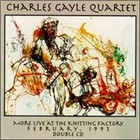 ME: Sure thing. My work with Charles Gayle does intertwine with my recordings during this period. I didn't remain idle for long. Charles Gayle had heard good things about me and he decided to try me out in his band. The result of that effort can be heard on disc two of the double-disc set put out by the Knitting Factory—More Live at the Knitting Factory. I didn't last very long with Charles. He has decided to use Michael Wimberly instead.
ME: Sure thing. My work with Charles Gayle does intertwine with my recordings during this period. I didn't remain idle for long. Charles Gayle had heard good things about me and he decided to try me out in his band. The result of that effort can be heard on disc two of the double-disc set put out by the Knitting Factory—More Live at the Knitting Factory. I didn't last very long with Charles. He has decided to use Michael Wimberly instead.
I like Michael Wimberly although to my ears, he's not a true free jazz drummer. He is a talented drummer in his own right. I like his drumming. Charles apparently likes to get drummers who aren't into free jazz. Michael Wimberly can be seen in the documentary that aired on Public Television called Exploring the World of Music. This series was very interesting. I learned a few things from watching this program. I hope it becomes available on DVD. class="f-right"> Return to Index...
Now, it's back to Alpha Phonics. When I did Time & Space Vol. 1, I wrote some of the pieces because I knew Rob Brown had studied with one of John Coltrane's teachers. Alto saxophonist Cara Silvernail came to my attention when I was with Charles Gayle. She had approached him about playing. She wanted to play this music so I gave her a chance. We did a gig at the old Knitting Factory on Houston Street. Cara didn't want to cut Rob Brown off as he was ending his solo. I had to stop playing and gently used my drumstick to push her forward to the microphone. I can't say I've ever seen a woman on saxophone playing free prior to Cara Silvernail. She sounded good. I learned during the rehearsals that she reads music well. She and Rob worked well together. Hill Greene played bass and provided solid support on this record date. There were some leftover compositions that didn't make it on the first CD. I plan to release them in the future. The music won't be enough to fill a CD. I like to give a minimum of one hour of music on my recordings. Some musicians who are working frequently come up short in this department. I don't understand why nor how working musicians put out CDs that are less than an hour.
After I did Time & Space Vol. 1, I changed the band and started using Sabir Mateen on tenor saxophone. I love what Rob Brown is doing however, drums balance better with the tenor saxophone given my style and the loudness of my drumming on occasions. Sabir was supposed to come to the recording of Time & Space Vol. 1, however, he never got my phone message. I owe drummer Tom Bruno a big thank you for letting me use Sabir Mateen. Remember, some leaders prefer to hold on to their musicians like they're personal property. The public would be very surprised to learn how selfish some of these musicians are. I had seen Sabir playing on the street with Test, the band with Tom Bruno, Sabir, Daniel Carter and Matt Heyner. We've had Matt Heyner on bass on a few occasions. I did work with Daniel Carter off and on. We had an unknown tenor saxophonist for one gig. I never ran into him again. I wonder if he's still in New York City. Some musicians are nomads. You see them today and tomorrow, it could be months or years before you see them again. Bassist Hill Greene has been working in my band over the years. He also works with singer, Jimmy Scott. I think it's a good idea for free jazz musicians to work with inside jazz artists. One helps the other in my opinion. We have also worked briefly with the legendary trumpet player Roy Campbell.
I also did a performance once with electric guitarist Loren Mazzacane Connors. He is the opposite of me. He plays using softer dynamics and specializes in playing at slow tempos. I tend to be more upbeat and into quick tempos. It's hard to describe his sound. I know that if Loren got more exposure, a lot of guitar players would copy what he's doing. I hear a transcendental New Age quality in his playing. I have heard Alice Coltrane use this sound on some of her albums.
Hill Greene drove us—me and Sabir Mateen—to Bob Rusch's place in upstate New York. We did the album, Red Sprites & Blue Jets. This record really helped Sabir's career. He was working when the CD came out, I wasn't. I've always had to keep a low profile because of my job. Now that the job is behind me, I'm concentrating on music. The events of September 11th have had a negative impact on my career. Things are harder now than they ever were however, I'm sure we'll break through in the future. Progress is slow but I'm not complaining. My drumming is rock solid and keeps getting better. I do need to get more CDs out. We're working on it.
AAJ: What was it like to open for Sonic Youth?
ME: I'm glad you asked that question. I would be remiss if I didn't mention the show we did when we opened for Sonic Youth. Thurston Moore is a huge fan of free jazz. He's doing what John Coltrane tried to do, that is, help as many musicians as possible. He has helped drummer William Hooker, me, tenor saxophonist Paul Flaherty, drummer Chris Corsano, David S. Ware, and many others in free jazz. This is what we need more of, not the petty jealousies, rivalries, and vindictiveness which some artists continue to perpetuate into infinity. We played at the Academy Theater right across the street from the New York Times building. It has since been renovated as part of the renewal plan for the 42nd Street area. I hardly recognize this area now. It looks different from how it was when I was a kid.
This happened on Saturday, October 21, 1995. This was the best sound I've ever had playing in front of a live audience. I could hear Sabir Mateen and Hill Greene clearly. Because the sound was better than average, it changed our musical presentation. The band locked into a much more musical approach than usual. It wasn't the loud drumming that I normally get into since I can't hear the horn player most of the times. On this Saturday afternoon, it was a very musical presentation of melodic free jazz. The young teenagers in the audience went wild after our show. Thurston had arrived and he was sitting on the side listening to us play. He was very pleased with our performance. He wanted me to do more shows with him, but my commitment to my day job was the problem. I told Thurston to use Sabir. Thurston wanted to record Sabir. I told him to go ahead do it, that wouldn't be a problem. I try to help the musicians that work for me to get ahead. This is how Tom Bruno and Sabir got to work with Sonic Youth. I did get Sabir and Hill recorded the very next year when we did Red Sprites & Blue Jets. I appreciate and thank Thurston Moore for his magnanimous support. This is so rare in the world of jazz. I wonder how many artists that Thurston has helped have bothered to publicly thank him.
I did work with Thurston Moore when I filled in for William Hooker at a performance that took place at the Knitting Factory. According to my notes, that was on January 11, 1996. Thurston should consider working with me in the future and do a recording. I'm sure the record will turn out fine.
AAJ: That brings us to your current guitarist Tor Snyder. How did you meet him?
ME: Tor Snyder began asking to join the band. He would come to our performances and he finally asked if he could play with us. My first guitarist, Peter Mazzetti, had moved to the West Coast. Peter was a rock guitarist. He wanted to try his hand playing free jazz. The first gig we did, his performance wasn't what I had in mind. He was very concerned that I wouldn't call him for the next gig, but I kept him in the band. As Peter continued playing with us, he relaxed and was able to give the band a unique timbre. I regret his departure due to his moving to the West Coast.
Tor sensed that I would be open to using a new guitarist. I didn't want to take him because I knew he was a member of Dennis Warren's Full Metal Revolutionary Jazz Ensemble. I'm not in the habit of stealing musicians from other people's bands. After Tor convinced me that he was going to remain in New York City, I decided to give him a chance. The first time he played with us, it didn't work out. I let Tor go and he returned several months later. This time, he played very well with the group and he's been in the band ever since. Sabir Mateen's career took off after the release of Red Sprites & Blue Jets. By the time I was able to start getting the band work four years later, Sabir was already up and running.
AAJ: How about your other two band members, saxophonist Ras Moshe and trumpeter James Duncan?
ME: Ras Moshe began approaching me about working in my band. I did use him because I can no longer get Sabir when I need a horn player. Sabir is always working these days; good for him! I wanted to add one more horn player and somehow James Duncan's name came up. I did see him play with Ras at one of Ras's The Music Now! Festival on Sunday, June 24, 2001 at the Orange Bear on Murray Street. I ran into him earlier this year in Midtown and I called out his name. It was James, however, he looked different since the last time I saw him. It must have been a year that had gone by since we last saw each other. James made inquires about the unreleased performance the band did previously. I told him I had not yet found a record company that would take it and put it out. It's hard to get your music out there sometimes. Both Ras and James happened to be in the right place at the right time. It's not likely I will expand the band. I could add a pianist, but, I'm not hearing the piano in my music right now. The Black Queen CD was specifically designed to help pianist Matthew Shipp and alto saxophonist Rob Brown get their foot in the door.
Tony Williams had problems with his band when he had John McLaughlin on electric guitar and Larry Young on organ. Jazz venues said the band was too rock-oriented, while rock venues said the group was too jazzy. Sometimes, an artist can't win. The industry has caught up with Tony Williams Lifetime group and now they're saying what a great band it was. It's hard to build a career when you're in no man's land. If people are saying your group is this, that and the other, the artist suffers greatly. An artist needs support now, not tomorrow or thirty years from now. This is what I'm facing today with my band Slipstream Time Travel. Most record companies won't record us. I have to do it myself, somehow.
class="f-right"> Return to Index...
AAJ: What about your recent album, Kaivalya, Vol. 1, with Paul Flaherty?
ME: Paul has been a staple in Cadence Magazine for many years. He came to see me play when I did a duo with tenor saxophonist Arthur Doyle at a church in Amherst. Arthur wanted me to learn his music. I didn't leave David S. Ware to learn somebody else's music. I have my own and I want to pursue my own creative impulses. I recognized Paul right away. His photo has been shown in Cadence Magazine over the years. We recorded enough materials for two albums. The second album will be released in the future. Right now, critics seem to like this powerful duo performance. I believe these albums will serve as templates for future duo performances between drums and horns. The music on these albums isn't a free-for-all. The music is well thought-out with outstanding improvisation. The tenor saxophone/drums duo has come a long way since John Coltrane and Rashied Ali on Interstellar Space. I wouldn't be surprised if other musicians use the formula Paul and I used on Kaivalya, Vol. 1. This album is available in some stores but fans can always order it online at Cadence Magazine's site provided at the end.
I had met Arthur Doyle through electric guitarist, Rudolph Grey. Some of you might not realize this is the same person who wrote the book, Nightmare of Ecstasy. This book was picked up by one of the Hollywood studios and made into the movie, Ed Wood, starring one of my favorite actors, Johnny Depp. Rudolph's book is still available at most bookstores, including amazon.com. I had the opportunity to work with Rudolph on two occasions. The first was a gig I did with him along with Arthur Doyle, & Wilbur Morris, at the West Beth Theater. I did a another performance with Rudolph and Charles Gayle at a place called the Cooler. This was actually a location that was used as a slaughterhouse in the past. It was located off Ninth Avenue, not far from the A train 14th Street subway stop. The slaughtering of animals was no longer being done but the space was filled with the deaths of many dead animals. I thought the vibes were very creepy. I used to pick up meat my mom and dad had ordered at a meat market located behind the Port Authority building on tenth avenue. I would stop by there after doing rehearsals when I was with the All City High School Band. I often had to wait an hour since this market was constantly busy.
Rudolph had sent me a letter explaining what he wanted me to do on the opening piece. I don't always check my mailbox so I told him, I had not received his correspondence. Rudolph sighed expressing disappointment and came over explained what he wanted. I listened to him talk while I was setting up my drums. When we hit, I gave Rudolph exactly what he wanted. He was very pleased after the set and he ran over and very excitedly shook my hand. Before we played, he went to the back and told the people doing the video taping not to use the psychedelics visual effects. These images are commonly used for music that's doesn't fall within the mainstream. Filmmakers, please do not use those 1960s special effects for the free jazz. I find it very disrespectful and/or demeaning to this musical genre. We have enough problems without the general public thinking we're odd balls from another planet.
A classic example of this occurred on the BET network when Carlos Santana was interviewed on Jazz Central. Those psychedelic images were promently displayed while Carlos was speaking. Carlos Santana is a long term meditator and because of that some folks think the practice of meditation is bizarre, weird or the result of someone tripping on LSD [meditation experiences]. There is more than enough resesearch evidence available which shows that meditation is good for the body. It can improve one's health and reduce stress. I believe meditation is the perfect vehicle for bringing about balance between the body, mind, and spirit.
If I remember correctly, a video was made of this performance at the Cooler, although I don't have a copy. William Hooker went on with his band first. That was videotaped also. As I watched the monitor, the film maker was using psychedelic images during Hooker's performance. I prefer to have a straight video done under bright lights. Some think that because jazz musicians are cool and hip, the house lights need to be turned down low to the level of a candle. I prefer bright lights as it makes it easier for videotaping and those taking photos in the audience. I played better at this performance than the one at the West Beth Theater. It's always a pleasure working with Charles Gayle. I was glad to work with Rudolph again since I love the sound of an electric guitar. In my next lifetime, I may learn to play this instrument.
AAJ: I noticed that your CDs have a theme in science and the exploration of outer space? Why do you focus on these subjects?
Tags
PREVIOUS / NEXT
Support All About Jazz
 All About Jazz has been a pillar of jazz since 1995, championing it as an art form and, more importantly, supporting the musicians who make it. Our enduring commitment has made "AAJ" one of the most culturally important websites of its kind, read by hundreds of thousands of fans, musicians and industry figures every month.
All About Jazz has been a pillar of jazz since 1995, championing it as an art form and, more importantly, supporting the musicians who make it. Our enduring commitment has made "AAJ" one of the most culturally important websites of its kind, read by hundreds of thousands of fans, musicians and industry figures every month.



